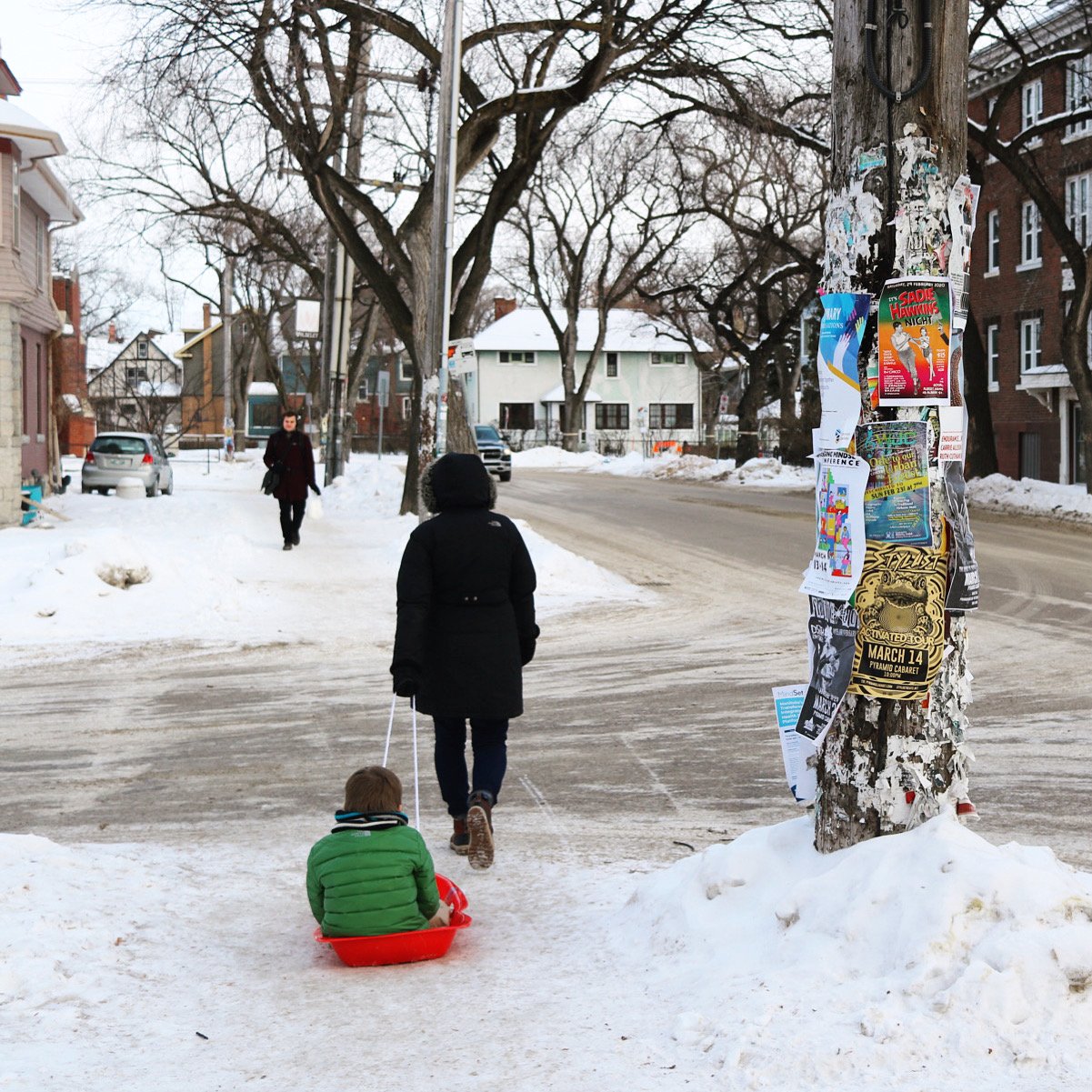Snow Clearance isn’t Gender Neutral
Person pulling child on a small sled in Wolseley (Photo by: Nicole Roach, Winnipeg, MB)
Canada is a northern country, with many cities experiencing sub-zero temperatures for several months of the year. Across the country, the degree of winter can range from rainy Vancouver to the dry cold in Saskatoon. Although many Canadians experience winter differently, snow is usually a part of it.
Given this reality, most cities and towns are tasked with snow clearance, with a wide range of policies, priorities, and approaches between them. For example, some cities clear sidewalks to a compact snow surface, whereas others use special plows to reveal pavement. Some cities make residents clear their own sidewalks, and some cities won’t let residents clear bike lanes.
While there are differences, a consistent theme across many Canadian cities - and even around the world - is that snow clearing policies and practices often prioritize men over women. This is demonstrated through the modes, locations, and methods that are applied to winter maintenance. Here are a few reasons why snow clearance isn’t gender neutral - despite what some people think.
Person with dog walking through deep snow on sidewalk (Photo by: Holly Hixson, Montréal, QC)
Mode
Women are more likely to walk and take public transit, whereas men are more likely to drive. Delayed snow clearing has a significant impact on people walking, rolling, or trying to push a stroller. Loose snow can feel like sand, making it challenging to walk through, and deep snow requires sufficient winter boots and lifting of the knees, which poses financial and physical barriers. Similarly, for someone in a wheelchair, using mobility aids, or toting toddlers, trying to get through deep snow or over snow piles can be impossible, and in many cases, dangerous.
Person cycling in winter at The Forks (Photo by: Nicole Roach, Winnipeg, MB)
Poorly maintained sidewalk with small icy path (Photo by: Stephanie Bertolo, Toronto, ON)
Transportation is essential because it unlocks access to services, amenities, recreation, and social connections. Many municipalities prioritize snow clearing based on the types of services that can be accessed through a particular route, or based on how many vehicles travel through it. However, if essential amenities can’t be reached by walking, biking, or transit because of snow, then the people who frequent those modes have decreased access. By clearing roads before clearing sidewalks, bike paths, and transit stops, many snow clearance policies prioritize men driving over women taking other modes of transport.
Stairs closed off due to inadequate snow clearance (Photo by: Nicole Roach, Vancouver, BC)
Large piles of snow at intersection, making bike crossing button difficult to access (Photo by: Sharee Hochman, Winnipeg, MB)
Location
Women are the primary caregivers of children and aging relatives, with women doing 75% of the world’s unpaid care work. Trends from other countries have found that women are three times more likely than men to take children to school. Many schools and daycare facilities begin at 8 or 9 am, requiring drop-offs before the typical 9-5 work day would start. Furthermore, in low-income, marginalized communities, kids are more likely to rely on active modes of travel, rather than being driven to school or accessing school bussing services. Children are especially challenged by uncleared snow on walking routes, as they have smaller legs to overcome deep snow and large piles along their journeys.
Deep snow on sidewalk and high snow piles (Photo by: Holly Hixson, Montréal, QC)
Despite many women and children walking, and needing to be at school or daycare early each week day, many snow clearing policies prioritize roads that are major thoroughfares which move large amounts of traffic towards the downtown cores for standard 9-5 workdays.
Furthermore, many schools are located in residential areas, with kids often traveling through side streets that rely on residents to clear the sidewalks. Some people are unable to shovel their sidewalks due to time constraints or mobility issues, leaving many residential sidewalks as a dangerous patchwork of poorly maintained snow and ice conditions.
Family walking on cleared path at The Forks (Photo by: Sharee Hochman, Winnipeg, MB)
Icy sidewalk (Photo by: Holly Hixson, Montréal, QC)
Methods
Women make up the majority of elderly people and disabled persons, as women statistically live longer and are more likely to have a disability than men. This makes many women disproportionately vulnerable to poorly maintained sidewalks and intersections, especially when it comes to slippery conditions.
Stairs in the process of being shovelled (Photo by: Nicole Roach, Vancouver, BC)
Icy sidewalk next to school and busy road (Photo by: Holly Hixson, Montréal, QC)
Pedestrians are injured three times more often than motorists in icy conditions. In a Swedish study, 79% of pedestrian injuries occurred during the winter months, and women made up 69% of those who had been injured in incidents that didn’t involve others. Two-thirds of these pedestrians had slipped and fallen in poor conditions, with nearly half having moderate to serious injuries. Furthermore, women’s injuries tended to be more severe than men’s in these instances.
While women of all ages and abilities are vulnerable to injury when slipping and falling on ice, the clearance policies are not adequately addressing the safety risks. When snow is cleared to a “compact” surface (which can be a successful approach when done well) the temperature variations common in shoulder seasons can melt the snow, creating icy divots that can be particularly dangerous.
Similarly, when paths are not brushed to pavement, a layer of ice can remain underneath, and a light snow can make that ice a hidden risk. Many municipalities and individuals use salt to help break up the ice, but salt can pose environmental risks, and it isn’t always distributed equally, creating safety gaps across cities.
Narrow pathway on Corydon Street (Photo by: Sharee Hochman, Winnipeg, MB)
Non-Sexist Snow Clearance
In Canada and other northern countries, these policies were not intentionally designed to benefit men and discriminate against women. However, as outlined by Caroline Criado Perez, author of Invisible Women, “the men (and it would have been men) who originally devised the schedule knew how they travelled and designed around their needs. They didn’t set out to exclude women. They just didn’t think about them.”
Some cities have set out to reverse that trend, by intentionally thinking about women in their snow clearance policies and providing the resources needed to do this well. A leader in this space is Karskoga, Sweden, a city that began re-evaluating all of their policies in 2011 to be considered through a gendered lens - including snow clearing. While Canadian cities haven’t explicitly brought a gender-lens to their snow clearance yet, cities like Edmonton and Montréal are beginning to prioritize winter cycling through expansion of winter bike routes and improved maintenance and prioritization for active modes all year round.
Shifting and re-prioritizing the modes, destinations, and methods of snow clearance would benefit women, but also everyone else who may be walking, rolling, skiing, sledding, or skating anywhere.
Canadian cities have an opportunity to improve gender equity after every snowfall, and let’s face it, we have a lot of them! Let’s seize each snowfall and make Canadian winters better for everyone.
Resources
https://www.edmonton.ca/city_government/initiatives_innovation/wintercity-strategy
https://www.fsg.org/blog/can-snow-clearing-be-sexist/
https://www.cbc.ca/news/politics/gender-analysis-budget-snow-sweden-1.4494640
https://www.cbc.ca/news/canada/ottawa/sweden-snow-clearing-gender-ottawa-1.4500636
https://www.theguardian.com/society/2017/dec/05/sweden-gender-equality-uk-government
https://americawalks.org/snow-clearing-shows-us-what-cities-care-about/
https://99percentinvisible.org/episode/invisible-women/
https://usa.streetsblog.org/2018/01/24/why-sweden-clears-walkways-before-roads/
https://medium.com/@GLAYPP/the-diversity-gap-3b4a2e29b563
https://www.cbc.ca/news/canada/ottawa/ottawa-city-snow-clearing-not-good-enough-1.6733344













